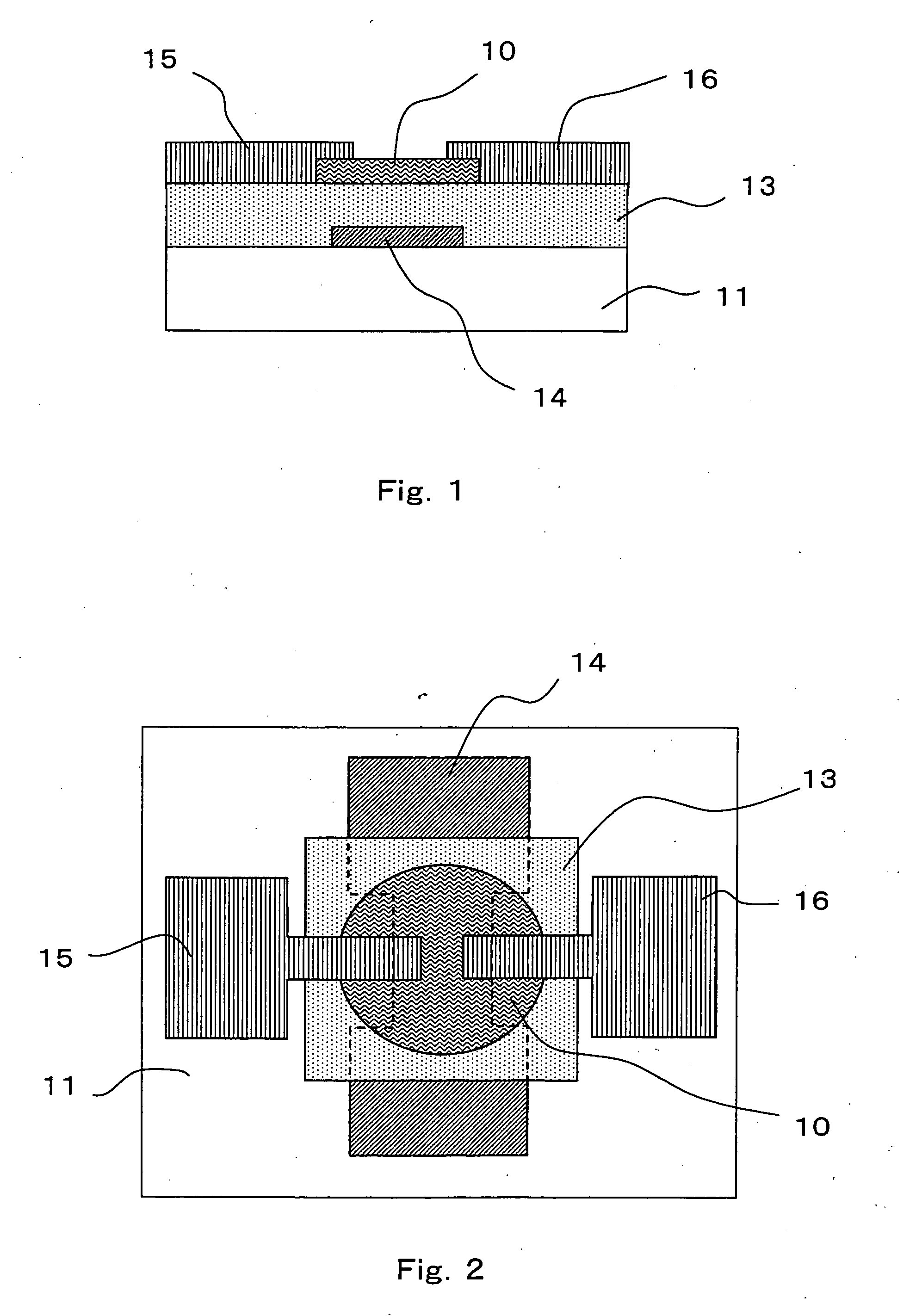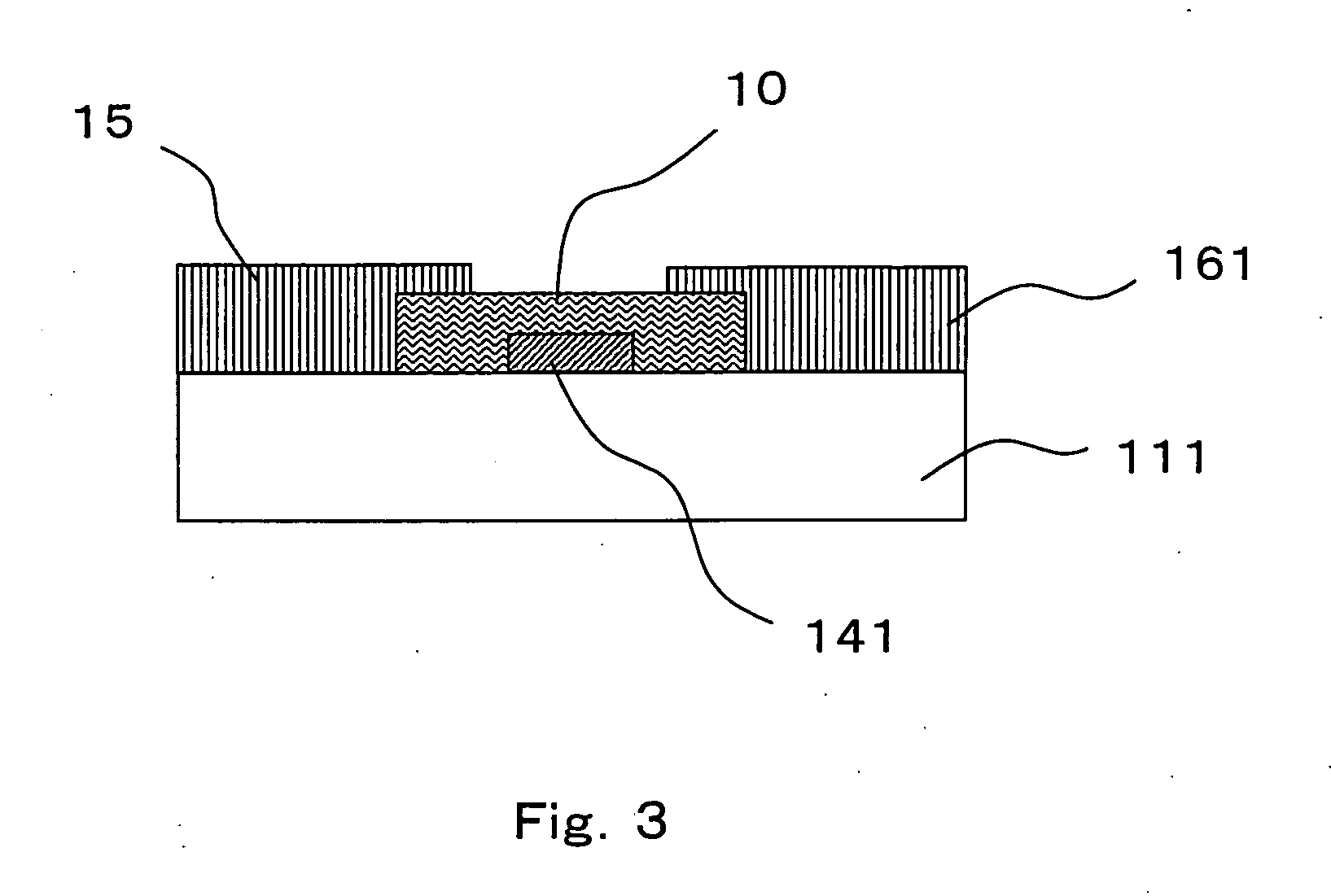Electroric device, integrated circuit, and method of manufacturing the same
a technology of integrated circuits and electromechanical devices, applied in thermoelectric devices, nanostructure manufacturing, nanoinformatics, etc., can solve the problems of insufficient integration techniques, reduced probability of occurrence, and very thin fibrous material of carbon nanotubes, etc., to achieve high availability, stably patterned, and high productivity.
- Summary
- Abstract
- Description
- Claims
- Application Information
AI Technical Summary
Benefits of technology
Problems solved by technology
Method used
Image
Examples
example 1
[0277] A MOS-FET carbon nanotube transistor was manufactured through a flow of the method of manufacturing an electronic device shown in FIGS. 4 and 5. It should be noted that reference numerals in FIGS. 4 and 5 may be used in the description of this example.
(A) Applying Step (A-1) Preparation of Cross-Linking Application Solution (Adding Step)
(i) Purification of Single-Wall Carbon Nanotube
[0278] Single-wall carbon nanotube powder (purity 40%, manufactured by Sigma-Aldrich Co.) was sifted through a sieve (125 μm in pore size) in advance to remove a coarse agglomerate. 30 mg of the remainder (having an average diameter of 1.5 nm and an average length of 2 μm) were heated at 450° C. for 15 minutes by using a muffle furnace, and then a carbon substance other than a carbon nanotube was removed. 15 mg of the remaining powder were immersed in 10 ml of a 5-N aqueous solution of hydrochloric acid {prepared by diluting concentrated hydrochloric acid (a 35% aqueous solution, manufactured...
example 2
[0308] A MES-FET carbon nanotube field effect transistor shown in FIG. 3 was produced in the same manner as in Example 1 except that the insulating film forming step was omitted. At this time, the gate electrode width and the distance between the source and drain electrodes were set to 500 μm and 1,500 μm, respectively. Then, the field effect transistor was subjected to measurement by means of a parameter analyzer 4156B (manufactured by Agilent Technologies) in the same manner as in Example 1 to confirm a change in electric conductivity between the source and the drain with the gate voltage Vgs. The result confirmed that the current between the source and the drain can be controlled by the gate voltage (FIG. 11).
example 3
[0309] A carbon nanotube structure was formed by using a cross-linking application solution using a multi-wall carbon nanotube, and a MOS-FET carbon nanotube field effect transistor shown in FIG. 1 was produced in the same manner as in Example 1. A method of forming an applied film will be shown below. The other steps were the same as those of Example 1.
(A) Applying Step
(A-1) Preparation of Cross-Linking Application Solution (Addition Step)
(i) Addition of Carboxyl Group . . . Synthesis of Carbon Nanotube Carboxylic Acid
[0310] 30 mg of multi-wall carbon nanotube powder (purity: 90%, average diameter: 30 nm, average length: 3 μm, manufactured by Science Laboratory Inc.) were added to 20 ml of concentrated nitric acid (a 60 mass % aqueous solution, manufactured by KANTO KAGAKU) for reflux at 120° C. for 20 hours to synthesize a carbon nanotube carboxylic acid.
[0311] The temperature of the solution was returned to room temperature and the solution was subjected to centrifugal se...
PUM
| Property | Measurement | Unit |
|---|---|---|
| Young's moduli | aaaaa | aaaaa |
| diameter | aaaaa | aaaaa |
| diameter | aaaaa | aaaaa |
Abstract
Description
Claims
Application Information
 Login to View More
Login to View More - R&D
- Intellectual Property
- Life Sciences
- Materials
- Tech Scout
- Unparalleled Data Quality
- Higher Quality Content
- 60% Fewer Hallucinations
Browse by: Latest US Patents, China's latest patents, Technical Efficacy Thesaurus, Application Domain, Technology Topic, Popular Technical Reports.
© 2025 PatSnap. All rights reserved.Legal|Privacy policy|Modern Slavery Act Transparency Statement|Sitemap|About US| Contact US: help@patsnap.com



